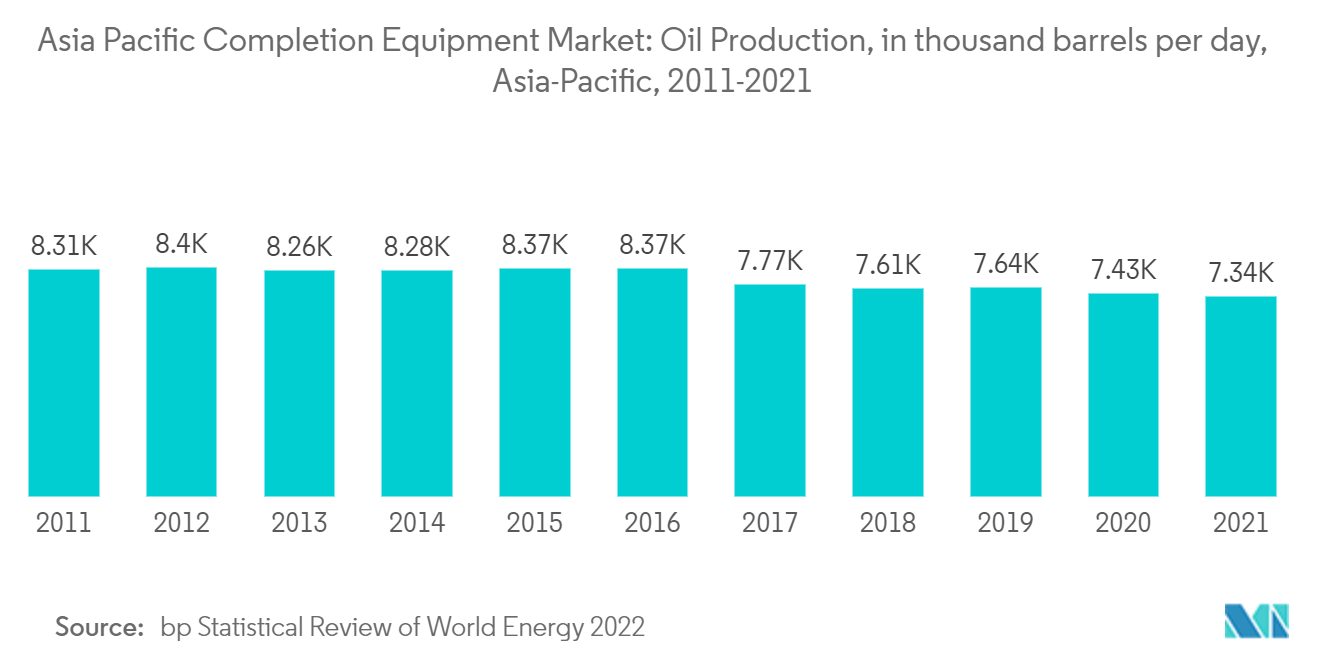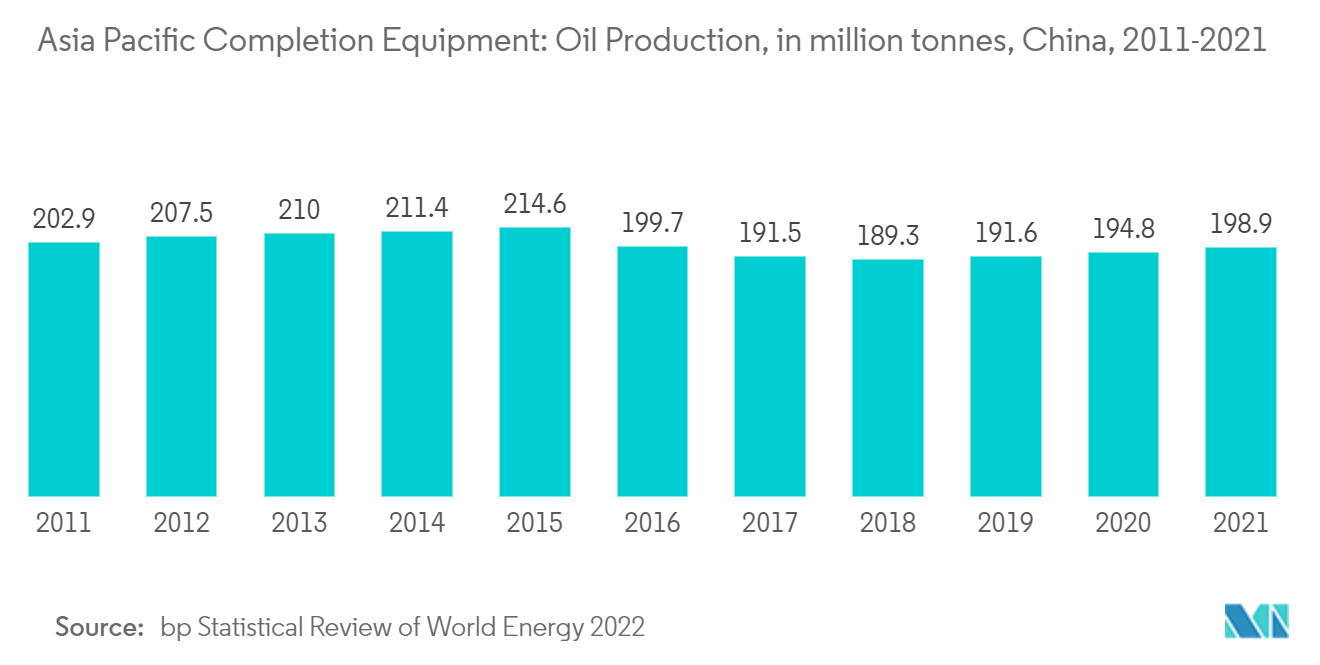Market Trends of Asia-Pacific Completion Equipment Industry
This section covers the major market trends shaping the APAC Completion Equipment Market according to our research experts:
Offshore Segment to Witness Significant Growth
- In the offshore segment, the first intervention is expensive and high-risk; well completions equipment and services have proven their value in managing production from multilateral wells and horizontal wells with multiple zones. Further advancements in technologies are expected to aid the growth of the market.
- The improvements in the completion equipment have incorporated new paradigms in the sector, like intelligent or thoughtful well completion. Intelligent completions include permanent downhole sensors that transmit data to the surface for local or remote monitoring in a digital wellness platform. All these data may or may not be automated but delivered to increase the production of the well. These systems are being used in the offshore segment as a method to decrease the production of water from the wells.
- India is the second largest crude oil producer in the Asia-Pacific region and accounted for around 10% of the regional crude oil production in 2021, according to the BP Statistical review of world energy 2022. Although the country has a relatively less complex and new oil and gas infrastructure than China, India's oil & gas industry includes various installations, including drilling rigs, production platforms, refineries, pipelines, terminals, and others.
- As of June 2022, India has 77 active rigs. The country's oil production has been falling for almost a decade due to aging fields and the absence of significant discoveries for years. Both state-owned and private players have been working on investment plans to raise recovery from older fields.
- In May 2022, Oil and Natural Gas Corporation (ONGC) drafted a comprehensive roadmap to intensify its exploration campaign, allocating about USD 4 billion in capital expenditures during FY 2022-25. ONGC holds two blocks for exploration in the Andaman Basin under the Open Acreage Licensing Policy (OALP). The Indian government has also acquired seismic data in some sectors within 'No-Go' areas, and a few prospects have already been identified. In the next three years, ONGC plans to drill six wells (two under its commitment to work and four under government assistance).
- Malaysia's oil and gas industry investments remain at pace and are set to expand further. As of 2020, the proven oil reserves of Malaysia reached 2.7 billion barrels, and natural gas reserves stood at 32.1 trillion cubic feet.
- In December 2021, Petronas signed two agreements regarding upstream investment in Malaysia. One agreement is a memorandum of understanding (MoU) with Petroleum Sarawak Berhad (PETROS) relating to a staggering increase of gas supplies to Sarawak, eventually raising the allocation to 1.2 billion cubic feet per day. Another one is a commercial agreement with the Sabah state government to develop Sabah's oil and gas industry.
- As of 2021, Asia-Pacifc has an aggregate production rate of 7 335 thousand barrels of crude oil per day and 669 billion cubic meters per day of natural gas.
- As of October 2022, the offshore rig count in the Asia-Pacific region is estimated by Baker Hughes Company to be around 86 units. An increase in exploration and production in areas such as the South China Sea and the Bay of Bengal may aid the growth of the offshore segment of the market.
- Hence, the offshore sector is expected to be the fastest-growing segment in the forecast period due to an increase in investments, technological advancement, and oil production.

China to Dominate the Market
- China was the largest producer of oil in the region in 2021. It is also among the largest user of well-completion techniques, which, among others, are used in the economically viable recovery of unconventional sources of hydrocarbons in the country's shale plays. This is because shale oil and gas reservoirs are more complicated to handle and tend to mature faster than conventional wells. Therefore, unconventional reservoir wells require higher usage of well completion equipment and services to produce the oil.
- Crude oil production in the country has increased by 2.1%, to 198.9 million tonnes, in 2021 from 194.8 million tonnes in 2020. The output may increase further in the forecast period and boost the China completion equipment and services market.
- As of June 2022, the country had around 38 offshore active rigs and no onshore active rigs. This, in turn, indicates the dominance of offshore assets in the country's upstream segment. As of 2021, more than 60% of China's offshore hydrocarbon resources are located in deepwater and ultra-deepwater areas where semi-submersibles, drillships, and other floating assets have a strong presence.
- Petrochina, a state-owned oil and gas company, has approximated the CAPEX for 2021 as USD 37 billion. Furthermore, the CAPEX for 2021 is more than global majors, including Saudi Arabian Oil Co., Exxon Mobil Corp., and Shell Plc. The government of China also announced, in early 2021, increased domestic production of coal, oil, and gas over the next five years.
- Further, China Petroleum & Chemical Corp, also known as Sinopec, is planning its highest capital investment in history for 2022. echoing the call for energy companies to raise production. Sinopec was estimated to have spent USD 31.1 Billion in the upstream oil and gas segment, especially the crude oil bases in Shunbei and Tahe fields and natural gas fields in Sichuan province and the Inner Mongolia region.
- In January 2022, CNOOC announced net production targets for 2023 and 2024, estimated to be 640 million to 650 million barrels of oil equivalent and 680 million to 690 million barrels of oil equivalent, respectively. The company also announced its capital expenditure for 2022 is budgeted at RMB 90 billion (over USD 14 billion) to RMB 100 billion (over USD 15.6 billion), while the capital expenditures for exploration, development, production, and others will account for approximately 20%.
- Hence, China is expected to dominate the market in the forecast period due to an increase in production, advancements in technologies, and high efficiency in aiding oil and gas production.

